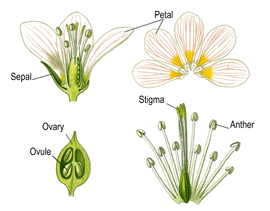Potential Pollinating Insects
Life History
There are many important pollinating insect species in the orders:
- Hymenoptera (bees, wasps, and ants)
- Lepidoptera (butterflies and moths)
- Diptera (flies)
- Coleoptera (beetles)
As adults, many of the species within these orders feed on pollen and/or nectar from flowers. They forage from plant to plant and may initiate pollination by transferring pollen from an anther to a stigma. Female bees (Apoidea) and pollen wasps (Masarinae) provision their nests with pollen and/or nectar that they actively collect onto their bodies. Their larvae then feed on the collected pollen and nectar. Yucca moth (Prodoxidae) larvae do not feed on pollen or nectar but on the seeds of yucca plants. The adults pollinate the yucca plant by actively collecting pollen onto their palps and then placing the collected pollen on a receptive stigma to ensure proper seed set for their offspring.
Insect pollinators are usually multi-habitat insects, requiring resources found in different habitats at different times. For instance most pollinating insects require:
- Nest sites (many bees and wasps)
- Larval feeding sites (beetles, butterflies, moths, flies, and some wasps)
- Hunting sites (some wasps and flies)
- Over-wintering sites
Furthermore, all of these sites must occur in areas with optimal (or at least tolerable) light, temperature, and humidity levels, and perhaps have relatively low densities of natural enemies. The dependence of native pollinators on the appropriate habitats must be recognized. Populations will not persist in a habitat if all life stage requirements are not met. A bumble bee species might require abandoned rodent burrows for nest sites and a particular range of flower types as pollen and nectar sources. Many solitary bees and wasps require specific nesting substrate (e.g., soil banks, decaying wood), as well as a variety of materials for nest construction such as mud, resin, leaves, plant hairs, or pebbles. These resources support the pollinator populations, and in return, the pollinators aid in the reproduction and maintenance of genetic diversity of the plant community and interact with other organisms as prey or host items.
Pollination
Pollination is the transfer of pollen grains that leads to the germination of the pollen grain on a stigma and fertilization of a plant ovule resulting in seed/fruit set. Pollen grains can be transferred from the anther to the stigma of the same flower or they can be transferred to another flower of the same or another plant. Pollen movement results in genetic exchange and the recombination of genes. Self-pollination (the transfer of pollen between anthers and stigmas of the same plant) can lower genetic diversity. To compensate, flowering plants use several modes of pollen transfer to cross-pollinate:
- Wind pollination (anemophily)
- Water pollination (hydrophily)
- Animal pollination (zoophily)
Pollination by insects (entomophily) occurs in ~67% of flowering plants throughout the world. In temperate environments, plants and insects are typically opportunistic with regards to one another because of the yearly and seasonal variations in diversity and abundance, therefore, neither plants nor insects usually depend on one species for their pollination or resource needs. As altitude or latitude increases, greater proportions of plants are pollinated by opportunistic pollinators. Research has shown that the most important pollinators in the high arctic of the Northwestern Territories of Canada were Diptera, specifically the families Empididae and Syrphidae. Many of the flowers in these areas were pollinated primarily by flies where as others were pollinated by bumble bees. Similarly, another study near Springville, UT at elevations of 1495 m and 3170 m found that relative species richness of Hymenoptera decreased with increasing elevation, but dipterans richness increased. Beetle and butterfly richness was low, relative to bees and flies, at both sites but also decreased with elevation.









